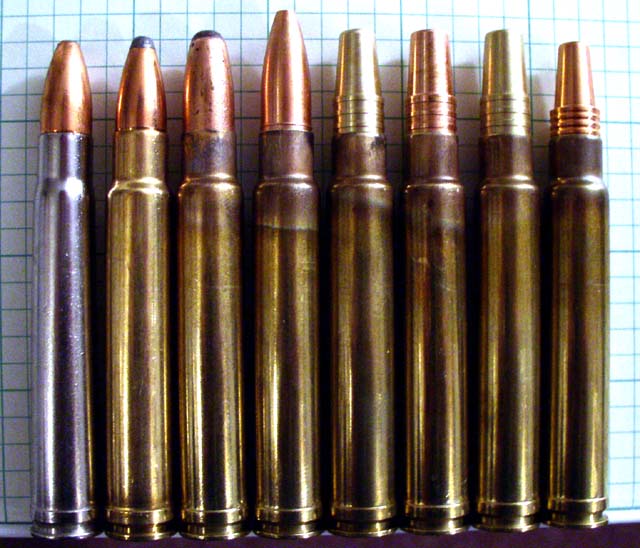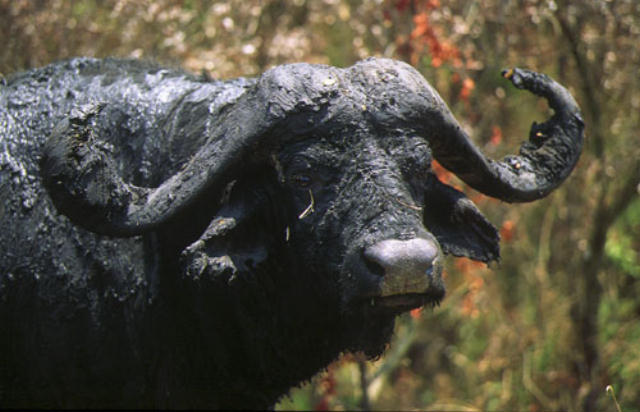
375 Weatherby
R. A. Berry


THE RIFLE
Winchester M-70 Classic Stainless .375 H&H rechambered to .375 Weatherby using a Dave Manson reamer with 0.375” freebore length. Barrel 24 inches. Magazine box is 3.625” in length. The scope and mounts: a Leupold Vari-X III 2.5x-8x with Leupold QRW rings and bases, with square recoil stop on bottom of each ring.
RELOADING COMPONENTS
Brass:
Hornady basic sized to .375 Weatherby, trimmed to 2.850”, and necks annealed.
Primer:
Federal GM215M
Bullets:
250 to 350 grains
Propellants:
Reloder 15
IMR-4350
H4831SC
Norma MRP
Average Temperature: 50 degrees F.
Chronographed 15 feet from muzzle.
Groups for 3 shots at 100 yards, center-to-center, rounded to nearest tenth of inch.
|
Powder |
Velocity |
Group |
Bullet & C.O.A.L. |
|
77.0 Reloader 15 |
2755 |
1.3 |
250 Barnes X FB 3.600 |
|
77.0 |
2762 |
0.9 |
260 Nosler Ballistic Tip 3.600 |
|
78.0 |
2818 |
0.8 |
|
|
79.0 |
2845 |
0.9 |
|
|
77.0 |
2763 |
0.5 |
265 Groove MI 3.600 |
|
78.0 |
2782 |
0.6 |
|
|
79.0 |
2805 |
1.5 |
Ejector marks – Do not use |
|
77.0 |
2748 |
0.6 |
270 Bridger Brass FN 3.600 |
|
78.0 |
2779 |
0.8 |
|
|
79.0 |
2826 |
0.9 |
|
|
77.0 |
2708 |
0.7 |
270 Hornady SP 3.600 |
|
76.0 |
2607 |
1.6 |
300 Hornady Steel jacket 3.585 |
|
76.0 |
2611 |
0.9 |
300 Bridger Brass FN 3.604 |
|
77.0 |
2627 |
0.8 |
300 Bridger Copper FN 3.606 |
|
77.0 |
2669 |
0.5 |
300 Bridger Walterhog 3.720 |
|
78.0 |
2717 |
0.138 |
Ejector marks – Do not use |
|
73.0 |
2417 |
1.0 |
350 Barnes original 3.610 |
|
89.0 IMR 4350 |
2836 |
0.8 |
260 Nosler Ballistic Tip 3.600 |
|
88.0 |
2704 |
0.9 |
300 Nosler Partition 3.565 |
|
88.0 |
2759 |
1.0 |
300 Sierra GameKing 3.600 |
|
88.0 |
2680 |
0.8 |
300 Bridger Brass FN 3.706 |
|
87.0 |
2634 |
0.5 |
300 Bridger Copper FN 3.610 |
|
88.0 |
2676 |
1.4 |
Ejector marks – Do not use |
|
89.0 |
2719 |
0.6 |
300 Bridger Walterhog 3.726 |
|
87.0 |
2629 |
1.0 |
300 Barnes XFB Can 3.593 |
|
87.0 |
2671 |
1.1 |
300 Hornady FMJ 3.598 |
|
84.0 |
2502 |
1.6 |
350 Barnes Original 3.610 |
|
90.0 H 4831SC |
2580 |
0.9 |
300 Bridger Brass FN 3.710 |
|
90.0 |
2556 |
1.3 |
300 Bridger Copper FN 3.610 |
|
90.0 |
2508 |
0.7 |
300 Bridger Walterhog 3.730 |
|
90.0 |
2550 |
1.8 |
300 Barnes XFB Can 3.620 |
|
90.0 |
2578 |
1.6 |
300 Hornady FMJ 3.583 |
|
85.0 |
2380 |
1.5 |
350 Barnes Original |
|
89.0 |
2454 |
1.0 |
|
|
92.0 Norma MRP |
2742 |
1.0 |
300 Sierra GameKIng 3.600 |
|
93.0 |
2773 |
2.5 |
|
|
91.0 |
2667 |
2.5 |
300 Bridger Brass FN 3.600 |
|
91.0 |
2633 |
1.0 |
300 Bridger Copper FN 3.600 |
|
89.0 |
2595 |
0.6 |
300 Bridger Walterhog 3.720 |
|
90.0 |
2616 |
0.8 |
|
|
91.0 |
2641 |
0.4 |
|
|
88.0 |
2512 |
1.0 |
350 Barnes Original 3.600 |
|
89.0 |
2540 |
1.2 |
|
|
90.0 |
2563 |
1.5 |
|
|
|
|
|
|
(All loads were crimped when possible, on cannelure, groove, or between driving bands. The 350 grain Barnes was not crimped.)
Weatherby factory load, .375 Weatherby (Norma brass and primer): Advertised velocity is 2800 fps in a 26” barrel, so the below 24” velocity supports the claim very well.
Unknown
Powder
(N-204?) 300 Nosler Partition 3.565 88.5 2734 1.1
Factory .375 H&H ammo fired in this rifle before and after the conversion from .375 H&H to .375 Weatherby:
Remington (advertised 2530 fps):
Before: 300 Swift a-Frame 3.555” ???? 2473 1.0
After: 2367 0.8
This is a practical trip saver ammunition interchangeability.
When the point of impact of the above .375 Weatherby factory load is +3.0” at 100 yards, the POI of the above .375 H&H factory load is +1.3” at 100 yards, IN THIS RIFLE.
The Leupold Scope and QRW mounts held up very well, with no loosening or change of POI throughout the testing. Again, these are the latest version, with the square recoil stop on the bottom of each ring. The 6x48 base screws were replaced with the stronger 8x40 screws and red Loctite applied when the rifle was converted to .375 Weatherby.
The above maximum useful loads are likely just below the SAAMI maximum average standard for the .375 Weatherby: 55,152 CUP or 63,861 PSI.
The loads shown with ejector marks may be over this pressure level. Beware of ambient temperature effects. Work up from 10% below the maximum trouble free loads shown. I suspect Norma 204 powder would also be excellent.
Handloaders have the choice of new Norma made Weatherby brass with proper headstamp readily available now. This brass is about 20 grains lighter, and has about 3 grains greater water capacity than my brass formed from Hornady basic. Using the Norma brass will lower pressures and velocities versus these loads in Hornady brass, so 0.5 to 1.0 grains more powder, depending on type powder, might be used in Norma brass. A comparison of brass is shown below, also including the Winchester WW-Super .375 H&H brass that has been fire formed to .375 Weatherby (beware the shorterWW brass):
Norma Hornady WW-Super
2.860 2.850 2.832 (case length in inches)
228.3 248.4 248.7 (case weight in grains)
111.5 108.2 108.4 (overflow water capacity)
Bullet length is a consideration with the monometals. Using a longer magazine of 3.750” would allow the long bullets to be seated out and still function through the magazine, rather than being only single loaded into the chamber. A .375 Weatherby with a longer box than the usual .375 H&H would be an advantage here.
Moly coating might also be considered for possible improvement of some loads.
Finally, here is a list of some bullet lengths measured from those I had on hand:
235 grain Speer SP: 1.043”
235 grain Barnes X: 1.210”
250 grain Swift A-Frame: 1.122”
250 Barnes XFB: 1.272”
250 grain Sierra GameKing: 1.180”
260 grain Nosler Ballistic Tip: 1.384”
260 grain Nosler Partition: 1.146”
265 Groove MI, copper FN solid: 1.345
270 grain Hornady SP: 1.274”
270 grain Speer SPBT: 1.295”
270 grain Barnes XFB Cannelured: 1.345”
270 grain Bridger brass FN solid: 1.323”
285 grain Speer Grand Slam: 1.252”
300 grain Hornady FMJ (steel jacket): 1.247”
300 grain Hornady RNSP: 1.174”
300 grain Sierra GameKing: 1.387”
300 grain Swift A-Frame: 1.297”
300 grain Bridger brass FN solid: 1.473
300 grain Bridger copper FN solid: 1.386”
300 grain Bridger Walterhog: 1.520”
300 grain Barnes XFB Cannelured: 1.472”
300 grain Nosler Partition: 1.337”
300 grain Winchester FMJ (steel jacket): 1.335”
300 grain Winchester Failsafe: 1.455”
300 grain Hornady BTSP: 1.418”
350 grain Barnes Original RNSP, 0.049” jacket: 1.425”